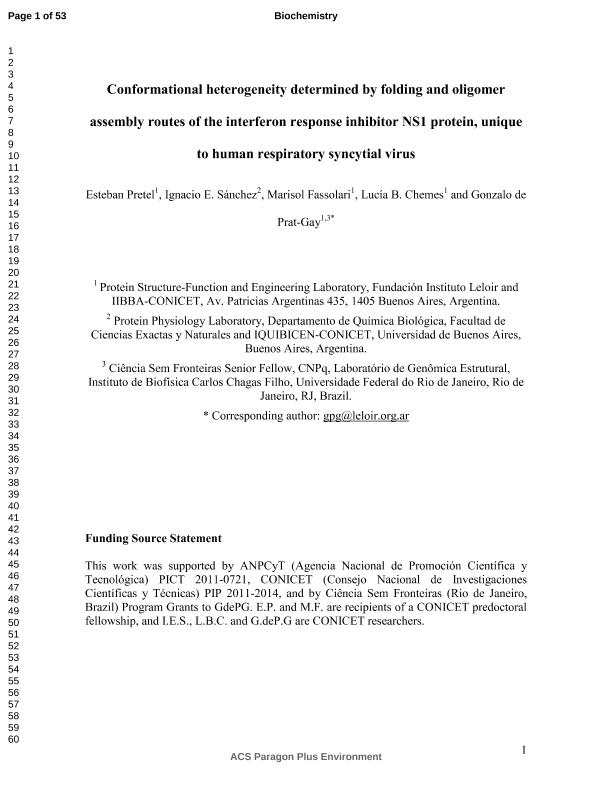Mostrar el registro sencillo del ítem
dc.contributor.author
Pretel, Miguel Esteban

dc.contributor.author
Sánchez Miguel, Ignacio Enrique

dc.contributor.author
Fassolari, Marisol

dc.contributor.author
Chemes, Lucia Beatriz

dc.contributor.author
de Prat Gay, Gonzalo

dc.date.available
2018-06-12T18:21:43Z
dc.date.issued
2015-08
dc.identifier.citation
Pretel, Miguel Esteban; Sánchez Miguel, Ignacio Enrique; Fassolari, Marisol; Chemes, Lucia Beatriz; de Prat Gay, Gonzalo; Conformational Heterogeneity Determined by Folding and Oligomer Assembly Routes of the Interferon Response Inhibitor NS1 Protein, Unique to Human Respiratory Syncytial Virus; American Chemical Society; Biochemistry; 54; 33; 8-2015; 5136-5146
dc.identifier.issn
0006-2960
dc.identifier.uri
http://hdl.handle.net/11336/48382
dc.description.abstract
The nonstructural NS1 protein is an essential virulence factor of the human respiratory syncytial virus, with a predominant role in the inhibition of the host antiviral innate immune response. This inhibition is mediated by multiple protein-protein interactions, and involves the formation of large oligomeric complexes. There is neither a structure nor sequence or functional homologues of this protein, which points to a distinctive mechanism for blocking the interferon response among viruses. The NS1 native monomer follows a simple unfolding kinetics via a native-like transition state ensemble, with a half-life of 45 minutes, in agreement with a highly stable core structure at equilibrium. Refolding is a complex process that involves several slowly interconverting species compatible with proline isomerization. However, an ultra-fast folding event of 0.2 milliseconds half-life is indicative of a highly folding compatible species within the undolded state ensemble. On the other hand, the oligomeric assembly route from the native monomer, which does not involve unfolding, shows a monodisperse and irreversible end-point species triggered by mild temperature change, with a half-life of 160 and 26 minutes at 37 and 47 degrees Celsius, respectively, and at low protein concentration (10 micromolar). A large secondary structure change into beta-sheet structure and the formation of a dimeric nucleus precedes polymerization by the sequential addition of monomers at the surprisingly low rate of one monomer every 34 seconds. The polymerization phase is followed by the binding to thioflavin-T indicative of amyloid-like, albeit soluble, repetitive beta sheet quaternary structure. The overall process is reversible only up until ~8 minutes, a time window where most of the secondary structure change takes place. NS1?s multiple binding activities must accommodate in a few binding interfaces at most, something to be considered remarkable given its small size (15 KDa). Thus, conformational heterogeneity, and in particular oligomer formation, may provide a means to expand its binding repertoire. These equilibria will be determined by variables such as macromolecular crowding, protein- protein interactions, expression levels, turnover, or specific subcellular localization. The irreversible and quasi-spontaneous nature of the oligomer assembly, together with the fact that NS1 is the most abundant viral protein in infected cells, makes its accumulation highly conceivable in conditions compatible with the cellular milieu. The implications of NS1 oligomers in the viral life cycle and the inhibition of host innate immune response remainto be determined.
dc.format
application/pdf
dc.language.iso
eng
dc.publisher
American Chemical Society

dc.rights
info:eu-repo/semantics/openAccess
dc.rights.uri
https://creativecommons.org/licenses/by-nc-sa/2.5/ar/
dc.subject
Ns1 Protein
dc.subject
Respiratory Syncytial Virus
dc.subject
Folding Kinetics
dc.subject
Aggregation Kinetics
dc.subject.classification
Otras Ciencias Biológicas

dc.subject.classification
Ciencias Biológicas

dc.subject.classification
CIENCIAS NATURALES Y EXACTAS

dc.title
Conformational Heterogeneity Determined by Folding and Oligomer Assembly Routes of the Interferon Response Inhibitor NS1 Protein, Unique to Human Respiratory Syncytial Virus
dc.type
info:eu-repo/semantics/article
dc.type
info:ar-repo/semantics/artículo
dc.type
info:eu-repo/semantics/publishedVersion
dc.date.updated
2018-06-07T20:01:46Z
dc.identifier.eissn
1520-4995
dc.journal.volume
54
dc.journal.number
33
dc.journal.pagination
5136-5146
dc.journal.pais
Estados Unidos

dc.description.fil
Fil: Pretel, Miguel Esteban. Consejo Nacional de Investigaciones Científicas y Técnicas. Oficina de Coordinación Administrativa Parque Centenario. Instituto de Investigaciones Bioquímicas de Buenos Aires. Fundación Instituto Leloir. Instituto de Investigaciones Bioquímicas de Buenos Aires; Argentina
dc.description.fil
Fil: Sánchez Miguel, Ignacio Enrique. Consejo Nacional de Investigaciones Científicas y Técnicas. Oficina de Coordinación Administrativa Ciudad Universitaria. Instituto de Química Biológica de la Facultad de Ciencias Exactas y Naturales. Universidad de Buenos Aires. Facultad de Ciencias Exactas y Naturales. Instituto de Química Biológica de la Facultad de Ciencias Exactas y Naturales; Argentina
dc.description.fil
Fil: Fassolari, Marisol. Consejo Nacional de Investigaciones Científicas y Técnicas. Oficina de Coordinación Administrativa Parque Centenario. Instituto de Investigaciones Bioquímicas de Buenos Aires. Fundación Instituto Leloir. Instituto de Investigaciones Bioquímicas de Buenos Aires; Argentina
dc.description.fil
Fil: Chemes, Lucia Beatriz. Consejo Nacional de Investigaciones Científicas y Técnicas. Oficina de Coordinación Administrativa Parque Centenario. Instituto de Investigaciones Bioquímicas de Buenos Aires. Fundación Instituto Leloir. Instituto de Investigaciones Bioquímicas de Buenos Aires; Argentina
dc.description.fil
Fil: de Prat Gay, Gonzalo. Consejo Nacional de Investigaciones Científicas y Técnicas. Oficina de Coordinación Administrativa Parque Centenario. Instituto de Investigaciones Bioquímicas de Buenos Aires. Fundación Instituto Leloir. Instituto de Investigaciones Bioquímicas de Buenos Aires; Argentina
dc.journal.title
Biochemistry

dc.relation.alternativeid
info:eu-repo/semantics/altIdentifier/url/https://pubs.acs.org/doi/abs/10.1021/acs.biochem.5b00615
dc.relation.alternativeid
info:eu-repo/semantics/altIdentifier/doi/http://dx.doi.org/10.1021/acs.biochem.5b00615
Archivos asociados
